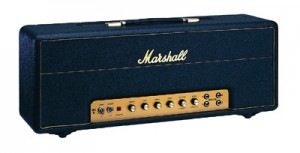The 100 Watt Marshall Super Lead was THE amp that started it all for the greatest rock and roll tones achieved – or I should say, the greatest LOUD rock and roll tones of the 60’s. Yes, the Vox AC 30, Fender Bassman, and even the Marshall JTM 45 came well before Marshall’s famous 100-watter, but it was the Super Lead that upped the ante for high-powered rock performances and really is the standard by which all rock guitar tone is judged. With generations of guitar greats such as Jimi Hendrix, Jimmy Page, Edward Van Halen, and countless others all using the Super Lead with stacks of 4 x 12 cabinets, there is no wonder why this amplifier is legendary; especially the very earliest models, known as the "plexi" heads.
 The Marshall Super Lead is a relatively simple amplifier and its circuit design has a bare number of features. Its tonal base is built around four EL-34 tubes, one power (earliest "plexi" models had a "lay down" style transformer) and output (in general – the earlier the model, the larger the core) transformer, three ECC-83 (a.k.a. 12AX7) pre-amp tubes using components that were hand-wired (until mid 1973) or put onto etched PC-boards (mid ’73 and on). Simple controls of presence, treble, mid, and bass controlled the e.q. section. The equalization was built around a passive circuit, i.e. turning any of the tone knobs to 10 would allow the full frequency of the selected tone band to pass through the circuit, but it did not add or boost that particular frequency on its own. This design helped the Super Lead to retain a smooth, uniform sound and distortion characteristic, but it is also why the Super Lead (and all Marshalls in general for that matter) were branded by some as being too limited in the number of tones that it could achieve.
The Marshall Super Lead is a relatively simple amplifier and its circuit design has a bare number of features. Its tonal base is built around four EL-34 tubes, one power (earliest "plexi" models had a "lay down" style transformer) and output (in general – the earlier the model, the larger the core) transformer, three ECC-83 (a.k.a. 12AX7) pre-amp tubes using components that were hand-wired (until mid 1973) or put onto etched PC-boards (mid ’73 and on). Simple controls of presence, treble, mid, and bass controlled the e.q. section. The equalization was built around a passive circuit, i.e. turning any of the tone knobs to 10 would allow the full frequency of the selected tone band to pass through the circuit, but it did not add or boost that particular frequency on its own. This design helped the Super Lead to retain a smooth, uniform sound and distortion characteristic, but it is also why the Super Lead (and all Marshalls in general for that matter) were branded by some as being too limited in the number of tones that it could achieve.
The SuperLead is a two-channel amplifier design that incorporates four inputs. All four inputs can be used simultaneously if one desires and channels can be linked or patched together to explore different sounds. One Volume control is offered per channel. There is no pre-amp or gain control as is offered in modern amplifier designs.
The omission of the pre-amp gain control is where the 100 Watt Marshall Super Lead’s legendary tone truly comes from. To get "the sound", one needs to turn up the amp to a loud volume to distort the EL-34 quartet power tube section. The Super Lead’s distortion tone is famously dynamic; play a guitar with an aggressive rhythm attack and the distortion’s harmonic overtones are smooth and lively; soften up your playing and the amp adjusts to your playing with its own warmer, soft-sounding clip.
Unfortunately, unless you’re an arena-playing rock star, you won’t often get the ability to play a Super Lead Marshall at the volume it sounds best. Gone are the days of in-your-face volume levels, especially in most club environments. So in this respect, is the Marshall Super Lead still even usable to a modern guitarist? The answer is fortunately, "Yes". Explore the reasons in the next article, "Tone Tips and Tricks for the Marshall Super Lead."